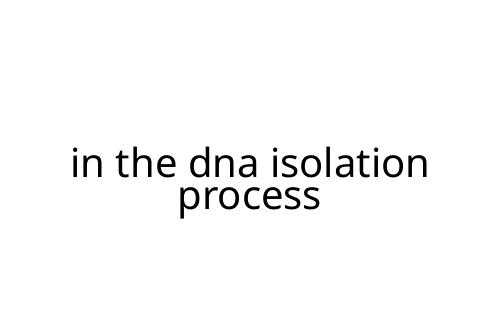in the dna isolation process
DNA isolation is a fundamental technique in biology, genetics, and biotechnology. Researchers, students, and lab technicians all encounter this process in some form. But what exactly happens in the dna isolation process, and why does it matter?
What Is DNA Isolation?
DNA isolation is the procedure of extracting deoxyribonucleic acid (DNA) from cells. This process is the first step in many genetic analyses, such as PCR, cloning, sequencing, or diagnostics. The goal: obtain pure DNA free from proteins, lipids, and other cell components that might interfere with downstream applications.
Key Steps in the DNA Isolation Process
-
Cell Lysis
The process starts by breaking open the cell membrane and nuclear envelope. This is often done using a buffer that contains detergents and salts. Lysis releases DNA and cellular contents into the solution. -
Removal of Contaminants
Proteins, lipids, and other molecules can contaminate the sample. Enzymes like proteinase K or chemical treatments (such as phenol-chloroform extraction) help separate DNA from these unwanted materials. -
DNA Precipitation
To collect DNA, alcohol (usually ethanol or isopropanol) is added. DNA is insoluble in alcohol, so it precipitates out of solution. You can then collect it by centrifugation or spooling. -
DNA Purification
The DNA pellet is washed to further remove impurities. Typically, a brief rinse with ethanol gets rid of salts and small molecules before the DNA is dried and rehydrated in a buffer or water.
Pros and Cons of Common Methods
- Spin Column Kits
- Pros: Fast, easy to use, high yield and purity
- Cons: Higher cost per sample
- Phenol-Chloroform Extraction
- Pros: Effective for difficult samples, cost-effective
- Cons: Involves toxic chemicals, more labor-intensive
- Salting-Out Method
- Pros: Inexpensive, no hazardous chemicals
- Cons: Lower purity, may leave some protein contamination
Practical Tips
- Start with fresh or well-preserved samples; degradation leads to lower DNA quality.
- Handle samples gently. Excessive shaking or vortexing can shear DNA and reduce its length, affecting some downstream uses.
- Always use clean, dedicated tools to avoid contamination.
Applications of Isolated DNA
The dna isolation process is crucial in a wide range of scientific and medical fields. Here are a few examples:
- Diagnostics: Testing for genetic diseases or pathogens
- Forensics: Identifying individuals based on their unique DNA profiles
- Research: Gene cloning, genetic engineering, sequencing projects
- Agriculture: Developing improved crop strains or animal breeds
Final Thoughts
In the dna isolation process, attention to detail makes a difference. The right method depends on your needs, budget, and type of sample. For most labs, spin column kits offer a good balance, but traditional methods still have their place. Ultimately, quality DNA isolation sets the foundation for reliable results in any genetic study.

 Leeyo Mattisonell, the founder of The Code Crafters Hub, is a trailblazer in the realm of software development and technology. With a passion for advancing the field, Mattisonell established The Code Crafters Hub as a premier destination for both software professionals and enthusiasts. His vision was to create a platform that not only delivers the latest industry news but also offers valuable insights into web and game development. Under his leadership, the hub has become a vital resource for understanding emerging technologies, including the Internet of Things (IoT) and cybersecurity trends. Mattisonell’s dedication to providing cutting-edge content ensures that the platform remains at the forefront of the ever-evolving tech landscape.
Mattisonell’s commitment to excellence is evident in the comprehensive and timely updates featured on The Code Crafters Hub. By focusing on dynamic web development techniques, game development innovations, and practical cybersecurity tips, he has positioned the hub as an essential tool for developers at all stages of their careers. Located in Warren, MI, and operating from 9 AM to 5 PM, the hub reflects Mattisonell’s dedication to fostering a knowledgeable and secure tech community. His leadership continues to drive the platform’s success, making it an invaluable resource for anyone looking to stay ahead..
Leeyo Mattisonell, the founder of The Code Crafters Hub, is a trailblazer in the realm of software development and technology. With a passion for advancing the field, Mattisonell established The Code Crafters Hub as a premier destination for both software professionals and enthusiasts. His vision was to create a platform that not only delivers the latest industry news but also offers valuable insights into web and game development. Under his leadership, the hub has become a vital resource for understanding emerging technologies, including the Internet of Things (IoT) and cybersecurity trends. Mattisonell’s dedication to providing cutting-edge content ensures that the platform remains at the forefront of the ever-evolving tech landscape.
Mattisonell’s commitment to excellence is evident in the comprehensive and timely updates featured on The Code Crafters Hub. By focusing on dynamic web development techniques, game development innovations, and practical cybersecurity tips, he has positioned the hub as an essential tool for developers at all stages of their careers. Located in Warren, MI, and operating from 9 AM to 5 PM, the hub reflects Mattisonell’s dedication to fostering a knowledgeable and secure tech community. His leadership continues to drive the platform’s success, making it an invaluable resource for anyone looking to stay ahead..
